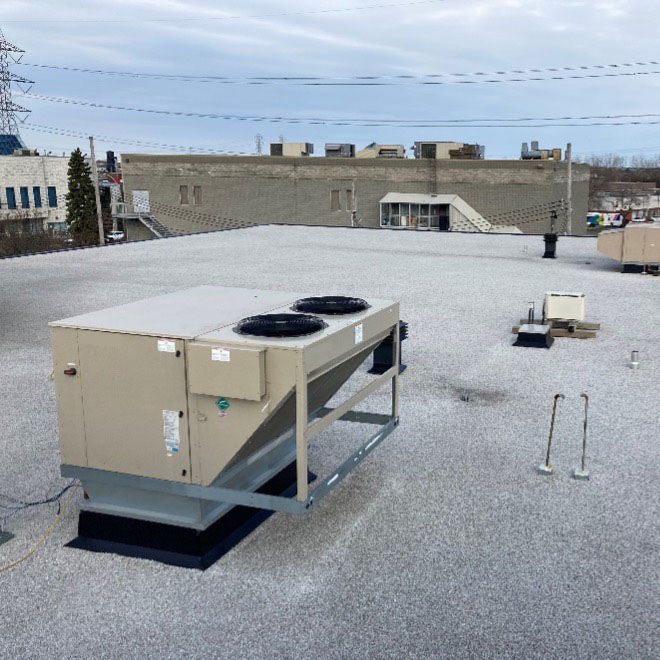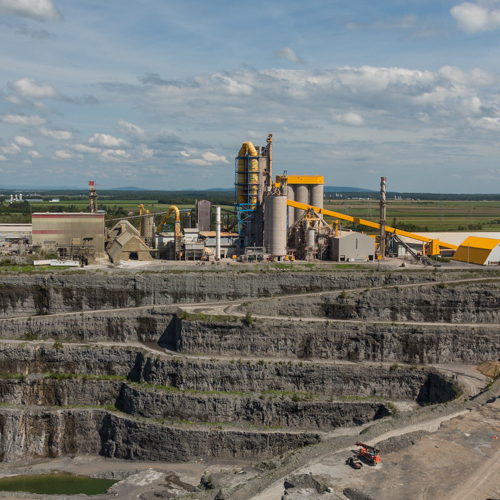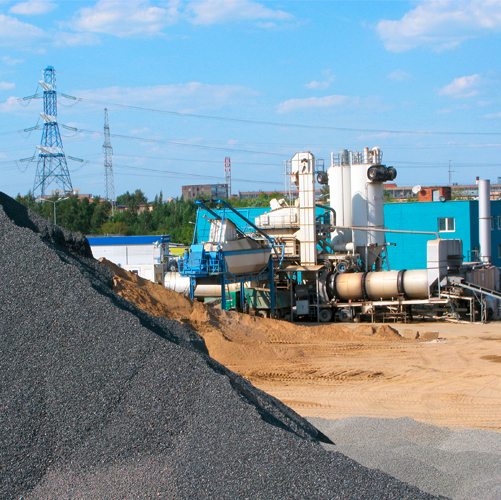Climate change has led us to reflect collectively on actions to reduce our GHG emissions. In order to achieve this, Énergir believes in the complementary use of electricity and natural gas to better heat buildings. Combining them enables the right energy to be consumed at the right time and at the best cost. As you’ll see in this article, hybrid rooftop units are one of the solutions that build on this complementarity.
What is a hybrid rooftop unit?
A hybrid rooftop unit is a space heating and cooling system that uses two energy sources to meet heating needs. Electricity powers a heat pump that provides space heating and cooling, while a natural gas burner takes over from the heat pump in very cold weather. In some cases, it may also increase heating capacity when the heat pump can’t keep up with demand.
A hybrid rooftop unit can easily replace a natural gas rooftop unit. Typically, a curb adapter is required to properly connect the rooftop unit to the existing mechanical system. In addition, like all other rooftop units, hybrid units can be either constant volume or variable volume.
How does it work?
The unit’s internal controls ensure that temperature control is performed by the heat pump, so that the natural gas burner doesn’t start until the outdoor temperature reaches a certain value. Although a heat pump requires less electrical capacity than an electric coil, the presence of the gas burner makes it possible to better manage consumption peaks and ensures that power demand is reduced.
Personalized control
If the switchover temperature is predefined at the factory, the unit’s controller allows this setpoint to be adjusted during installation. In regions where the electricity distributor offers rates based on outdoor temperatures, the user can make the change directly on the unit; however, some manufacturers recommend not changing these parameters.
Optimal integration, maximum savings
Settings can also be configured by connecting the unit to the Building Automation System (BAS), if one is present. Various schedules and settings can then be programmed to control the device. This allows you to take advantage of dynamic pricing and optimize the operation of the rooftop unit to reduce operating costs or meet previously identified GHG reduction targets.
A new, custom rate for dual energy systemsOffer coming soon for Énergir’s clientDual-energy electricity and natural gas for the commercial, institutional and multi-unit property sector is set to launch in the fall.
This offer will include generous grants to reduce the cost of purchasing and installing new dual-energy furnaces. You’ll also see recurring savings on your energy bills, thanks to Hydro-Québec’s new small- and medium-power dual-energy rate.
Important!
To benefit from these grants, you must wait for their launch before installing your equipment or registering for Hydro-Québec’s new small- and medium-power dual-energy rate.
In Québec, Hydro-Québec has been authorized by Régie de l’énergie to apply a new small- and medium-power dual-energy rate for space heating for its commercial and institutional customers. Hybrid rooftop units are one of the solutions eligible for this rate. Hydro-Québec’s dual-energy rate is based on a switchover temperature of -12°C (-15°C for some regions). The transfer to the backup source is carried out via a signal sent by a temperature sensor built into the meter if it’s outside, or installed outdoors if the meter is not outside. This probe dictates the timing of the transition from one energy source to another and not the internal controls of the hybrid rooftop unit.
A collaborative pilot project
Currently, neither hybrid rooftop units (heat pump/natural gas burner) nor electric auxiliary heat pump rooftop units are very common in Québec. That’s why Énergir wanted to fully understand how this type of device operates and its potential to reduce GHGs through a pilot project carried out in collaboration with Hydro-Québec. The project, which included several sites, aimed to validate the device’s energy performance and operation.
A variety of representative sites
For the 2022–2023 heating season, three sites were selected for a first validation phase.
- The first site was a 1,680 m2 office building with a parking structure. Two rooftop units were installed: a 25T unit with natural gas heating and a 7.5T hybrid unit. Perimeter heating was provided by a 185 MBH natural gas hot water boiler.
- The second site was an office space with a warehouse and two hybrid rooftop units, one 4T unit and one 10T unit. End coils rounded off the heating system, and the perimeter was equipped with electric baseboards.
- Finally, the third site served as a warehouse and was equipped with a 4T hybrid unit operating on its own, without any additional heat input.
| Project | Building type | Technology assessed | Existing heating characteristics | |
| Site 1 | Administrative office | 7.5T hybrid unit |
One other area covered by a 25T rooftop unit Hot water perimeter heating |
 |
| Site 2 | Business office |
One 10T hybrid unit One 4T hybrid unit |
Far end electric heat unit |
 |
| Site 3 | Warehouse | 4T hybrid unit |
No other heating system |
 |
Table 1 — Characteristics of pilot project sites
Three different control strategies
For the first phase of the project, none of the hybrid rooftop units were controlled by the temperature probe normally supplied by Hydro-Québec. Therefore, the units were evaluated using the control devices provided by the units themselves.
Amongst the four hybrid rooftop units installed, there were three different control strategies. One unit allowed for simultaneous operation of the heat pump and burner (figure 1), while the controllers on the other rooftop units allowed only one of the two energy sources to be used at a time (figures 2 and 3). Although the operating ranges of those units were wide and there was some overlap, both energy sources were not used at the same time. In addition, the natural gas burner was activated at a higher temperature on one unit than on the other. One reason for this is the use of natural gas during defrosting cycles.
Figure 1 — Control strategy allowing simultaneous use of both energy sources
Figure 2 — Control strategy allowing the use of only one of the two energy sources at a time
Figure 3 — Control strategy allowing the use of only one of the two energy sources at a time
Outdoor temperature: a determining factor for efficiency
The parameters measured in the pilot project validated the impact of outdoor temperature on the unit’s efficiency and capacity. One of the disadvantages of an electric heat pump is its reduced efficiency and capacity at low temperatures. All measurement results obtained from the units tested show this decrease. As expected, capacity decreases as the outdoor temperature decreases. The heat pump loses up to 37% of its capacity at -12°C. When the unit is used below that temperature, its capacity continues to drop. According to the manufacturer’s data, this decrease reaches 82% of the maximum capacity (figure 4), and the same is true for efficiency or the cœfficient of performance (COP). A backup source then becomes necessary and justifies the choice of a dual-energy rate. Based on the electricity distributor’s prerogatives, the rate structure is then adapted to make the dual-energy rate competitive by offering on a low cost during off-peak periods and a dissuasive rate during peak periods so that natural gas is prioritized during peak demand.

Figure 4 — Comparison of the efficiency (COP) and capacity of a hybrid rooftop unit (heat pump section) measured on site versus the manufacturer’s data
Cold and supply temperature: an obvious relationship
Like the COP and capacity, the supply temperature in heat pump mode decreases as the outdoor temperature drops (figure 5). Even above -12°C, the natural gas burner may operate if the supply temperature is too low to reach the desired set point.
When the natural gas burner is turned on (or off), there’s an increase (or decrease) in the supply temperature. For some hybrid rooftop unit models, this differential reaches 10°C in less than 10 minutes.

Figure 5 — Supply temperature (TSA) by hybrid unit operation
Preventing frost
The use of a hybrid rooftop unit may give rise to some concerns, such as possible frost buildup and ice formation on the heat exchanger. Although this situation occurred at one of the test sites, it was due to a conflict between the unit control strategy for starting the defrosting cycle and the operating time of the electric heat pump before switching to the natural gas burner. Due to this conflict, no defrosting cycle occurred, resulting in the ice accumulation.
Once the necessary adjustments were made and the control logic of the defrosting cycle was corrected, the unit started running defrosting cycles and never experienced any further frost buildup. Defrosting generally occurs when the outdoor temperature is between 5°C and -12°C. The duration of the defrosting cycle is variable, and it was not possible to correlate the duration with the weather conditions. However, it lasts longer when the relative humidity is high.

Figure 6 — Frost accumulation due to a conflict between the unit control strategies
Performance and GHG reduction potential: mixed results
The pilot project validated the energy performance of hybrid rooftop units. In particular, it showed that the type of interaction between energy sources can significantly influence the overall efficiency of these units. Thus, units that allow simultaneous use of electricity and natural gas are less efficient than units that use one energy source at a time, and this difference is significant. When the unit allows both sources of energy to operate simultaneously, the annual efficiency is 108%, whereas when only one source of energy can be used at a time, the annual efficiency can be as high as 226%.
Whether or not energy sources are used simultaneously also has an impact on GHG reduction potential. Emissions decreased by 35% when the burner could operate to fill the gap in the heat pump’s capacity, whereas when only one energy source was used at a time and the heat pump was prioritized until the switchover temperature—as much as its capacity permitted—emissions were reduced by nearly 90%.
| Annual energy consumption (kBtu/year) |
Reduction in energy consumption | Reduction in natural gas consumption | Reduction in GHG emissions (kg CO2eq/year) | |||
| Natural gas | Electricity | Total | ||||
| Strategy with possible simultaneous use of energy sources | ||||||
| Gas rooftop unit (Reference) | 8,100 | 0 | 8,100 | - | - | - |
| Hybrid rooftop unit | 5,300 | 780 | 6,080 | -25% | -35% | 148 (-35%) |
| Strategy prioritizing heat pump use | ||||||
| Gas rooftop unit (Reference) | 46,818 | 0 | 46,818 | - | - | - |
| Hybrid rooftop unit | 5,421 | 11,349 | 16,770 | -64% | -88% | 2,181 (-89%) |
Table 2
Conclusion
The pilot project provided a better understanding of how hybrid rooftop units work and established the viability of this technology as an efficient decarbonization solution that uses complementary energy distribution networks and does not impact peak electricity demand.
Hybrid rooftop units offer superior energy performance and enable power demand to be reduced without affecting comfort. Although still uncommon in Québec, these units are well suited to our climate. Their control systems can be easily connected to existing building systems and integrating them does not present any additional challenges compared to installing a conventional rooftop unit.
The combination of this decarbonization solution and dual-energy pricing provides competitive energy costs. It supports a smart energy transition and demonstrates that by leveraging complementary energy sources, we can achieve our collective GHG emission reduction targets without increasing pressure on the power system.
Marc Francoeur, P.Eng.
Team Lead, Technology & Energy Solutions
Continue reading











